The rapid U-drills market is valued at USD 1.4 billion in 2025 and is projected to reach USD 2 billion by 2035, rising at a 3.2% CAGR, adding USD 538.2 million in total. The scale and pace of expansion are steady, with modernized machining across automotive, aerospace, and industrial component manufacturing, where drilling performance influences throughput, dimensional accuracy, and cost-per-part. Between 2025 and 2030, the market increases to USD 1,648.0 million, contributing 36.3% of the decade's growth as facilities adopt CNC platforms and replace conventional drills. The larger 63.7% contribution during 2030–2035 points to deeper integration of optimized drill geometries, improved carbide grades, and wear-resistant coatings that support high-speed drilling in aluminum alloys, high-strength steels, and composites. Drill type segmentation reinforces these performance priorities, with single-blade systems holding ~63% share due to superior chip evacuation and setup flexibility, while combination types at ~37% offer multi-function efficiency in applications requiring chamfering or spot-facing within a single tool pass. By application, metal processing leads with ~41%, followed by material modification at ~28% and tools manufacturing at ~19%, reflecting widespread adoption across engine blocks, transmission housings, and aerospace structural machining.
Geographically, the market is led by China (4.3% CAGR) and India (4.0% CAGR), supported by automotive supply chain localization, aerospace component machining, and industrial policy incentives. Germany (3.6%) and the USA (3.0%) sustain growth through high-spec machining standards and precision manufacturing ecosystems, while Brazil (3.3%), the UK (2.7%), and Japan (2.4%) grow through incremental modernization rather than capacity expansion. Competitive structure remains moderately consolidated, with Sandvik Group, Sumitomo Electric, and Kennametal collectively holding a 28–32% share, while regional manufacturers such as Chain Headway, Wuxi HOPE Technology, and Dongguan Aken Precision Machinery compete through localized production, faster delivery cycles, and application-specific support near manufacturing hubs.

The market demonstrates strong momentum across developed and emerging manufacturing economies, where metalworking industries are transitioning from conventional drilling methods to advanced tooling systems that offer superior performance characteristics. Rapid U-drill technology addresses critical manufacturing challenges including hole straightness maintenance in deep-hole applications, chip evacuation efficiency in difficult-to-machine materials, and tool life consistency across extended production runs.
The automotive sector's shift toward lightweight materials and complex component geometries creates sustained demand for drilling solutions capable of processing aluminum alloys, high-strength steels, and composite materials with minimal tool wear and consistent quality output. Aerospace manufacturers are adopting rapid U-drills for structural component fabrication where hole accuracy directly impacts assembly tolerances and operational safety requirements. The technology's ability to produce burr-free holes with excellent surface finish reduces secondary finishing operations and accelerates production workflows.
Industrial machine shops and contract manufacturers are investing in rapid U-drill systems to enhance competitive positioning through improved productivity metrics and expanded material processing capabilities. The integration of advanced coating technologies and optimized drill geometries enables these tools to achieve cutting speeds 30-50% higher than conventional systems while maintaining tool life performance. However, initial capital investment requirements for specialized tooling systems and technical expertise barriers for optimal parameter selection may pose challenges to market expansion in cost-sensitive manufacturing segments and regions with limited access to technical training resources.
Between 2025 and 2030, the rapid U-drills market is projected to expand from USD 1.4 billion to USD 1,648.0 million, resulting in a value increase of USD 195.1 million, which represents 36.3% of the total forecast growth for the decade. This phase of development will be shaped by rising demand for precision metalworking solutions in automotive and aerospace sectors, product innovation in carbide insert technology and coating systems, as well as expanding integration with advanced CNC machining platforms and automated manufacturing lines. Companies are establishing competitive positions through investment in cutting-edge drill geometry designs, wear-resistant coating technologies, and strategic market expansion across automotive component manufacturing, aerospace structural fabrication, and industrial machinery production applications.
From 2030 to 2035, the market is forecast to grow from USD 1,648.0 million to USD 2 billion, adding another USD 342.9 million, which constitutes 63.7% of the overall ten-year expansion. This period is expected to be characterized by the expansion of specialized drilling systems, including advanced indexable insert designs and multi-functional tool configurations tailored for specific material types and hole diameter requirements, strategic collaborations between cutting tool manufacturers and machine tool builders, and an enhanced focus on tool life optimization and productivity enhancement. The growing emphasis on manufacturing efficiency and quality consistency will drive demand for advanced, high-performance rapid U-drill solutions across diverse metalworking applications.
| Metric | Value |
|---|---|
| Market Value (2025) | USD 1.4 billion |
| Market Forecast Value (2035) | USD 2 billion |
| Forecast CAGR (2025-2035) | 3.2% |
The rapid U-drills market grows by enabling manufacturers to achieve superior hole quality and drilling productivity while reducing machining cycle times in precision metalworking operations. Manufacturing facilities face mounting pressure to improve production efficiency and component quality, with rapid U-drill systems typically providing 40-60% cycle time reduction over conventional drilling methods, making these specialized tools essential for competitive manufacturing operations. The automotive and aerospace industries' need for precise deep-hole drilling creates demand for advanced U-drill solutions that can maintain tight tolerances, achieve excellent surface finishes, and ensure consistent hole straightness across diverse material types and production volumes.
Industrial automation initiatives promoting CNC integration and lights-out manufacturing drive adoption in automotive component fabrication, aerospace structural production, and general metalworking applications, where drilling efficiency has a direct impact on throughput capacity and manufacturing costs. The global shift toward lean manufacturing principles and Industry 4.0 implementation accelerates rapid U-drill demand as metalworking facilities seek tooling solutions that minimize non-productive time and maximize spindle utilization. However, limited awareness of optimal cutting parameters and higher initial tooling costs compared to conventional drills may limit adoption rates among small-scale machine shops and regions with traditional machining practices and limited technical support infrastructure.
The market is segmented by drill type, application, and region. By drill type, the market is divided into single blade and combination type. Based on application, the market is categorized into material modification, metal processing, tools manufacturing, and others. Regionally, the market is divided into Asia Pacific, Europe, North America, Latin America, and Middle East & Africa.
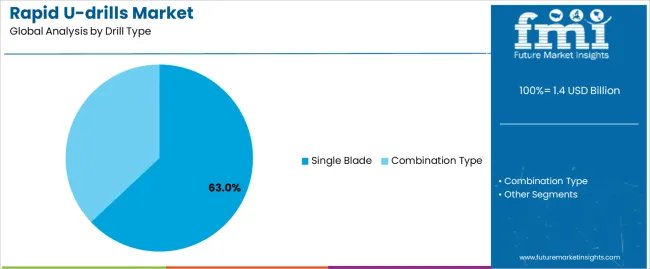
The single blade segment represents the dominant force in the rapid U-drills market, capturing approximately 63.0% of total market share in 2025. This advanced category encompasses standard diameter configurations, extended reach variants, and specialized geometries optimized for specific material applications, delivering efficient chip evacuation and superior hole straightness in deep-hole drilling operations. The single blade segment's market leadership stems from its versatile design architecture, cost-effective tooling solutions, and compatibility with standard CNC machining centers across automotive, aerospace, and general metalworking facilities.
The combination type segment maintains a substantial 37.0% market share, serving manufacturers who require multi-functional drilling capabilities through integrated spot-facing features, chamfering edges, and specialized cutting geometries that combine multiple operations in single tool passes.
Key advantages driving the single blade segment include:
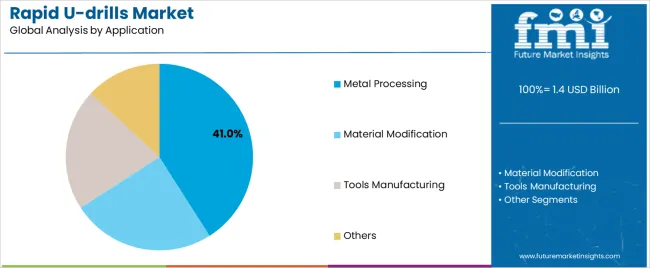
Metal processing applications dominate the rapid U-drills market with approximately 41.0% market share in 2025, reflecting the extensive adoption of deep-hole drilling solutions across automotive component manufacturing, aerospace structural fabrication, and general industrial metalworking operations. The metal processing segment's market leadership is reinforced by widespread implementation in engine block production (15.0%), transmission housing fabrication (13.0%), and structural frame drilling (13.0%), which provide essential productivity advantages and quality consistency in high-volume manufacturing environments.
The material modification segment represents 28.0% market share through specialized applications including surface treatment preparation (12.0%), heat exchanger manufacturing (10.0%), and precision component finishing operations (6.0%). Tools manufacturing accounts for 19.0% market share, driven by adoption in cutting tool production (8.0%), die and mold fabrication (7.0%), and precision tooling applications (4.0%). Other applications constitute 12.0% market share, encompassing energy sector components, heavy equipment manufacturing, and specialized industrial drilling requirements.
Key market dynamics supporting application preferences include:
The market is driven by three concrete demand factors tied to manufacturing efficiency and quality outcomes. First, automotive industry expansion creates increasing requirements for efficient drilling solutions, with global automotive production exceeding 85 million vehicles annually in major markets worldwide, requiring reliable rapid U-drill systems for engine block, transmission housing, and chassis component fabrication. Second, aerospace manufacturing growth and stringent quality requirements drive adoption of precision drilling technology, with rapid U-drills improving hole straightness by 40-50% while reducing drilling cycle times in aluminum alloys and titanium materials used extensively in aircraft structural components. Third, industrial automation initiatives and CNC machining center proliferation accelerate deployment across metalworking facilities, with rapid U-drills integrating seamlessly into automated production lines and enabling lights-out manufacturing capabilities in high-volume production environments.
Market restraints include initial investment barriers affecting small-scale machine shops and cost-sensitive manufacturing operations, particularly where conventional drilling methods remain adequate for less demanding applications and where capital budgets constrain adoption of specialized tooling systems. Technical expertise requirements for optimal cutting parameter selection pose adoption challenges for facilities lacking experienced machining personnel, as rapid U-drill performance depends heavily on proper speed, feed, and coolant settings that vary significantly across material types and hole depth requirements. Limited availability of application-specific technical support in emerging manufacturing markets creates additional barriers, as metalworking facilities require specialized training in tool setup procedures, troubleshooting methods, and maintenance practices to achieve target performance levels.
Key trends indicate accelerated adoption in Asian manufacturing hubs, particularly China and India, where automotive component production and aerospace manufacturing capabilities are expanding rapidly through government industrialization programs and foreign direct investment in manufacturing infrastructure. Technology advancement trends toward coated carbide inserts with enhanced wear resistance, optimized chip breaker geometries for improved chip control, and modular tool systems enabling rapid diameter changes are driving next-generation product development. However, the market thesis could face disruption if additive manufacturing technologies achieve breakthrough capabilities in producing complex components with integrated hole features, potentially reducing demand for conventional drilling operations in specific application segments.
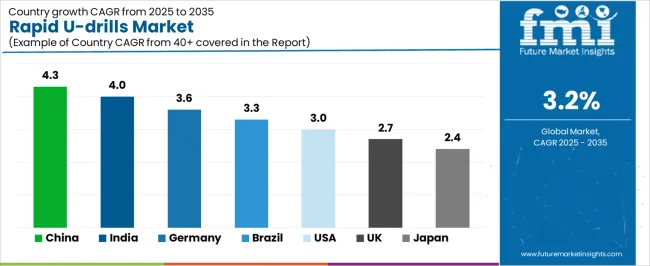
| Country | CAGR (2025-2035) |
|---|---|
| China | 4.3% |
| India | 4.0% |
| Germany | 3.6% |
| Brazil | 3.3% |
| USA | 3.0% |
| UK | 2.7% |
| Japan | 2.4% |
The rapid U-drills market is gaining momentum worldwide, with China taking the lead thanks to aggressive automotive manufacturing expansion and industrial modernization programs. Close behind, India benefits from growing aerospace component production and government manufacturing initiatives, positioning itself as a strategic growth hub in the Asia-Pacific region. Brazil shows strong advancement, where expanding automotive assembly operations and metalworking infrastructure development strengthen its role in South American manufacturing supply chains. The USA demonstrates robust growth through advanced manufacturing initiatives and aerospace sector investment, signaling continued adoption in precision metalworking applications. Meanwhile, Japan stands out for its precision machining expertise and advanced manufacturing technology integration, while UK and Germany continue to record consistent progress driven by automotive engineering centers and industrial equipment manufacturing. Together, China and India anchor the global expansion story, while established markets build stability and technology leadership into the market's growth path.
The report covers an in-depth analysis of 40+ countries top-performing countries are highlighted below.

China demonstrates the strongest growth potential in the Rapid U-drills Market with a CAGR of 4.3% through 2035. The country's leadership position stems from comprehensive automotive manufacturing expansion, intensive aerospace industry development programs, and aggressive industrial modernization targets driving adoption of advanced metalworking technologies. Growth is concentrated in major manufacturing regions, including Guangdong, Jiangsu, Zhejiang, and Shandong, where automotive component suppliers, aerospace manufacturers, and general metalworking facilities are implementing rapid U-drill systems for productivity enhancement and quality improvement. Distribution channels through industrial equipment distributors, cutting tool specialists, and direct manufacturer relationships expand deployment across automotive clusters, aerospace production bases, and industrial machinery manufacturing centers. The country's Made in China 2025 initiative provides policy support for advanced manufacturing technology adoption, including subsidies for precision tooling implementation and manufacturing automation upgrades.
Key market factors:
In the National Capital Region, Maharashtra, Tamil Nadu, and Karnataka industrial zones, the adoption of rapid U-drill systems is accelerating across automotive component manufacturing, aerospace fabrication facilities, and general metalworking operations, driven by Make in India initiatives and increasing focus on manufacturing competitiveness. The market demonstrates strong growth momentum with a CAGR of 4.0% through 2035, linked to comprehensive automotive sector expansion and increasing investment in precision manufacturing capabilities. Indian manufacturers are implementing rapid U-drill technology and advanced machining platforms to improve production efficiency while meeting stringent quality requirements in automotive and aerospace supply chains serving domestic and export markets. The country's National Manufacturing Policy creates sustained demand for advanced tooling solutions, while increasing emphasis on industrial automation drives adoption of precision drilling systems that enhance manufacturing productivity.
Germany's advanced manufacturing sector demonstrates sophisticated implementation of rapid U-drill systems, with documented case studies showing 35-45% cycle time reduction in automotive component drilling operations through optimized tooling strategies. The country's manufacturing infrastructure in major industrial regions, including Bavaria, Baden-Württemberg, North Rhine-Westphalia, and Lower Saxony, showcases integration of precision drilling technologies with existing CNC machining centers, leveraging expertise in automotive engineering and aerospace component production. German manufacturers emphasize quality standards and process optimization, creating demand for reliable rapid U-drill solutions that support productivity commitments and stringent dimensional accuracy requirements. The market maintains strong growth through focus on Industry 4.0 integration and manufacturing excellence, with a CAGR of 3.6% through 2035.
Key development areas:
The Brazilian market leads in Latin American rapid U-drill adoption based on expanding automotive manufacturing operations and growing metalworking infrastructure in major industrial centers. The country shows solid potential with a CAGR of 3.3% through 2035, driven by automotive sector investment and increasing domestic demand for precision-manufactured components across industrial equipment, agricultural machinery, and transportation sectors. Brazilian manufacturers are adopting rapid U-drill technology for compliance with automotive industry quality standards, particularly in engine component production requiring precise hole tolerances and in structural part fabrication where drilling efficiency impacts production economics. Technology deployment channels through industrial distributors, cutting tool representatives, and equipment financing programs expand coverage across automotive supply chains and general metalworking facilities.
Leading market segments:
The USA market leads in advanced rapid U-drill applications based on integration with sophisticated CNC machining systems and comprehensive manufacturing automation platforms for enhanced production efficiency. The country shows solid potential with a CAGR of 3.0% through 2035, driven by aerospace manufacturing expansion and increasing adoption of advanced metalworking technologies across automotive, defense, and industrial equipment production sectors. American manufacturers are implementing rapid U-drill systems for high-precision drilling requirements, particularly in aerospace structural components demanding tight tolerances and in automotive powertrain production where cycle time reduction directly impacts manufacturing economics. Technology deployment channels through industrial distributors, cutting tool specialists, and direct manufacturer relationships expand coverage across diverse metalworking operations.
Leading market segments:
The UK market demonstrates consistent implementation focused on automotive component manufacturing and aerospace structural production, with documented integration of rapid U-drill systems achieving 25-30% productivity improvements in engine component drilling operations. The country maintains steady growth momentum with a CAGR of 2.7% through 2035, driven by automotive manufacturing presence and aerospace industry requirements for precision drilling capabilities in advanced materials. Major industrial regions, including West Midlands, North West England, and South Wales, showcase deployment of advanced drilling technologies that integrate with existing manufacturing infrastructure and support quality requirements in automotive and aerospace supply chains.
Key market characteristics:
Japan's rapid U-drills market demonstrates sophisticated implementation focused on automotive component production and precision machinery manufacturing, with documented integration of advanced drilling systems achieving 30-35% cycle time reduction in high-precision metalworking operations. The country maintains steady growth momentum with a CAGR of 2.4% through 2035, driven by manufacturing excellence culture and emphasis on process optimization principles aligned with lean manufacturing philosophies. Major industrial regions, including Aichi, Kanagawa, Osaka, and Shizuoka, showcase advanced deployment of precision drilling technologies that integrate seamlessly with automated manufacturing lines and comprehensive quality control systems.
Key market characteristics:
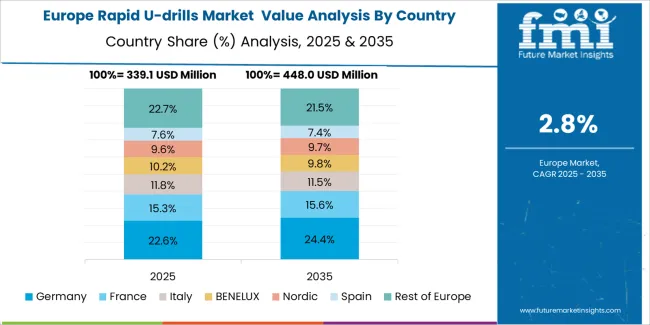
The rapid U-drills market in Europe is projected to grow from USD 377.4 million in 2025 to USD 637.7 million by 2035, registering a CAGR of 5.4% over the forecast period. Germany is expected to maintain its leadership position with a 32.5% market share in 2025, declining slightly to 31.8% by 2035, supported by its extensive automotive manufacturing infrastructure and major industrial centers, including Bavaria, Baden-Württemberg, and North Rhine-Westphalia production regions.
France follows with a 18.2% share in 2025, projected to reach 18.5% by 2035, driven by comprehensive automotive component production and aerospace manufacturing programs in major industrial regions. The United Kingdom holds a 14.7% share in 2025, expected to reach 14.9% by 2035 through automotive engineering centers and precision manufacturing facilities. Italy commands a 12.3% share in both 2025 and 2035, backed by automotive component production and machinery manufacturing. Spain accounts for 8.6% in 2025, rising to 8.8% by 2035 on automotive assembly operations and metalworking sector growth. The Rest of Europe region is anticipated to hold 13.7% in 2025, expanding to 14.2% by 2035, attributed to increasing rapid U-drill adoption in Nordic countries and emerging Central & Eastern European automotive manufacturing operations.
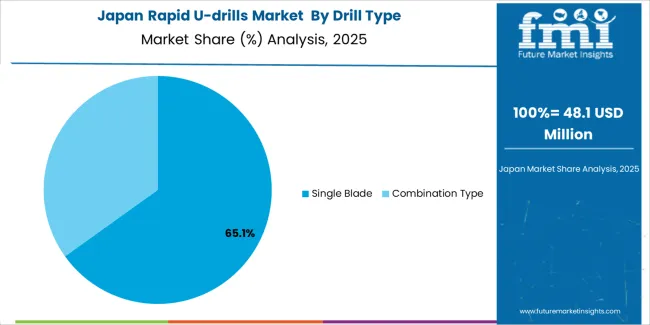
The Japanese rapid U-drills market demonstrates a mature and quality-focused landscape, characterized by sophisticated integration of single blade drilling systems with existing precision manufacturing infrastructure across automotive component production, machinery manufacturing, and industrial equipment fabrication operations. Japan's emphasis on manufacturing excellence and process optimization drives demand for precision drilling tools that support quality commitments and productivity targets in competitive manufacturing environments. The market benefits from strong partnerships between international cutting tool providers and domestic industrial distributors including major trading companies, creating comprehensive service ecosystems that prioritize technical support and application engineering programs. Industrial centers in Aichi, Kanagawa, Osaka, and other major manufacturing areas showcase advanced metalworking implementations where rapid U-drill systems achieve 98% dimensional accuracy compliance through optimized cutting parameters and comprehensive process control systems.

The South Korean rapid U-drills market is characterized by growing international technology provider presence, with companies maintaining significant positions through comprehensive technical support and application engineering capabilities for automotive component manufacturing and precision metalworking applications. The market demonstrates increasing emphasis on manufacturing automation and productivity enhancement, as Korean manufacturers increasingly demand advanced drilling solutions that integrate with domestic CNC machining infrastructure and sophisticated production management systems deployed across major industrial complexes. Regional cutting tool distributors are gaining market share through strategic partnerships with international manufacturers, offering specialized services including technical training programs and application-specific tooling solutions for automotive and industrial machinery production operations. The competitive landscape shows increasing collaboration between multinational cutting tool companies and Korean industrial equipment specialists, creating hybrid service models that combine international product development expertise with local technical support capabilities and rapid response systems.
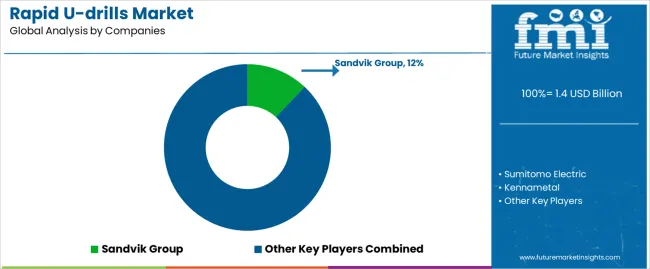
The rapid U-drills market features approximately 20-25 meaningful players with moderate fragmentation, where the top three companies control roughly 28-32% of global market share through established distribution networks and comprehensive product portfolios. Competition centers on cutting performance consistency, tool life reliability, and technical support capabilities rather than price competition alone. Sandvik Group leads with approximately 12.0% market share through its comprehensive metalworking solutions portfolio and global manufacturing presence.
Market leaders include Sandvik Group, Sumitomo Electric, and Kennametal, which maintain competitive advantages through global distribution infrastructure, advanced carbide insert technology, and deep expertise in application engineering across multiple industrial sectors, creating trust and reliability advantages with automotive manufacturers and aerospace fabrication operations. These companies leverage research and development capabilities in coating technology optimization and ongoing technical support relationships to defend market positions while expanding into emerging manufacturing markets and specialized application segments.
Challengers encompass Derek Inc and Chain Headway, which compete through specialized product offerings and strong regional presence in key manufacturing markets. Product specialists, including Dongguan Aken Precision Machinery, Shang Tzang Wang Enterprise, and Wuxi HOPE Technology, focus on specific drill configurations or regional markets, offering differentiated capabilities in custom tooling solutions, rapid delivery services, and competitive pricing structures.
Regional players and emerging cutting tool manufacturers create competitive pressure through localized manufacturing advantages and rapid response capabilities, particularly in high-growth markets including China and India, where proximity to automotive clusters provides advantages in technical support responsiveness and customer relationships. Market dynamics favor companies that combine proven drilling performance with comprehensive application engineering offerings that address the complete metalworking cycle from material selection through process optimization and quality assurance.
Rapid U-drills represent advanced drilling solutions that enable manufacturers to achieve 40-60% cycle time reduction compared to conventional drilling methods, delivering superior hole quality and manufacturing productivity with enhanced straightness accuracy and surface finish consistency in demanding metalworking applications. With the market projected to grow from USD 1.4 billion in 2025 to USD 2 billion by 2035 at a 3.2% CAGR, these precision drilling systems offer compelling advantages - productivity enhancement, quality improvement, and operational efficiency - making them essential for metal processing applications (41.0% market share), material modification operations (28.0% share), and manufacturing facilities seeking alternatives to conventional drilling methods that compromise productivity through longer cycle times and inconsistent hole quality. Scaling market adoption and technology deployment requires coordinated action across industrial policy, manufacturing infrastructure development, cutting tool manufacturers, metalworking facilities, and industrial automation investment capital.
How Governments Could Spur Local Production and Adoption?
How Industry Bodies Could Support Market Development?
How OEMs and Technology Players Could Strengthen the Ecosystem?
How Suppliers Could Navigate the Shift?
How Investors and Financial Enablers Could Unlock Value?
| Item | Value |
|---|---|
| Quantitative Units | USD 1.4 billion |
| Drill Type | Single Blade, Combination Type |
| Application | Material Modification, Metal Processing, Tools Manufacturing, Others |
| Regions Covered | Asia Pacific, Europe, North America, Latin America, Middle East & Africa |
| Country Covered | China, India, Germany, Brazil, USA, UK, Japan, and 40+ countries |
| Key Companies Profiled | Sandvik Group, Sumitomo Electric, Kennametal, Derek Inc, Chain Headway, Dongguan Aken Precision Machinery, Shang Tzang Wang Enterprise, Wuxi HOPE Technology, Hao Zheng Machine Tools, Shang Fuh Enterprise, ECHAINTOOL Precision, Orient Energy Technologies, Hon Jan Cutting Tools, Hangzhou Pavo Tools |
| Additional Attributes | Dollar sales by drill type and application categories, regional adoption trends across Asia Pacific, Europe, and North America, competitive landscape with cutting tool manufacturers and distribution networks, manufacturing facility requirements and specifications, integration with CNC machining centers and automated production systems, innovations in carbide insert technology and coating systems, and development of specialized drilling solutions with enhanced tool life and productivity capabilities. |
The global rapid u-drills market is estimated to be valued at USD 1.4 billion in 2025.
The market size for the rapid u-drills market is projected to reach USD 1.9 billion by 2035.
The rapid u-drills market is expected to grow at a 3.2% CAGR between 2025 and 2035.
The key product types in rapid u-drills market are single blade and combination type.
In terms of application, metal processing segment to command 41.0% share in the rapid u-drills market in 2025.






Full Research Suite comprises of:
Market outlook & trends analysis
Interviews & case studies
Strategic recommendations
Vendor profiles & capabilities analysis
5-year forecasts
8 regions and 60+ country-level data splits
Market segment data splits
12 months of continuous data updates
DELIVERED AS:
PDF EXCEL ONLINE
Rapid Microbiology Testing Market Forecast Outlook 2025 to 2035
Rapid Test Cards Market Size and Share Forecast Outlook 2025 to 2035
Rapid Prototyping Materials Market Size and Share Forecast Outlook 2025 to 2035
Rapid Test Readers Market Size and Share Forecast Outlook 2025 to 2035
Rapid Strength Concrete Market Size and Share Forecast Outlook 2025 to 2035
Rapid Self-Healing Gel Market Size and Share Forecast Outlook 2025 to 2035
Rapid Infuser Market Size, Growth, and Forecast 2025 to 2035
Rapid RNA Testing Kits Market Trends- Growth & Forecast 2025 to 2035
Rapid Hepatitis Testing Market – Demand & Forecast 2025 to 2035
Rapid Antigen Testing Market - Demand, Growth & Forecast 2025 to 2035
Market Leaders & Share in the Rapid Infuser Industry
Rapid Plasma Reagin Test Market
Rapid Coagulation Testing Market
Rapid Cook-High Speed Ovens Market
Mono Rapid Testing Market Size and Share Forecast Outlook 2025 to 2035
Veterinary Rapid Test Market Size and Share Forecast Outlook 2025 to 2035
Veterinary Rapid Tests Market Size and Share Forecast Outlook 2025 to 2035
Malaria Ag Rapid Testing Market - Growth & Forecast 2025 to 2035
Trichomonas Rapid Tests Market Size and Share Forecast Outlook 2025 to 2035
Chloramphenicol Rapid Test Strip Market Size and Share Forecast Outlook 2025 to 2035

Thank you!
You will receive an email from our Business Development Manager. Please be sure to check your SPAM/JUNK folder too.
Chat With
MaRIA